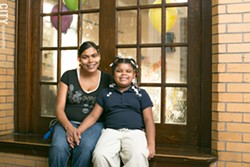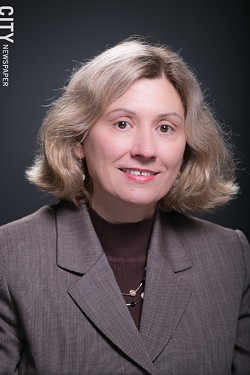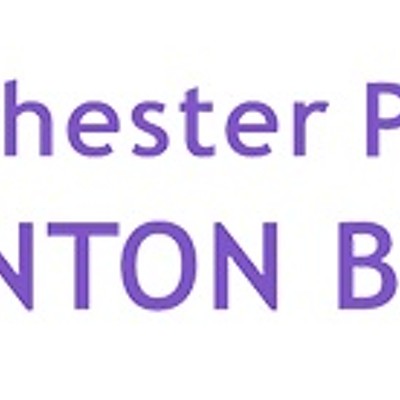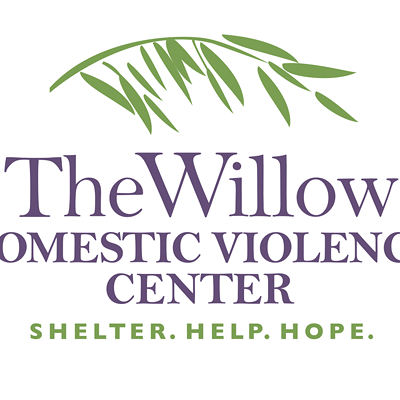[
{
"name": "500x250 Ad",
"insertPoint": "5",
"component": "15667920",
"parentWrapperClass": "",
"requiredCountToDisplay": "1"
}
]
When Latesha Green first walked through the door of School 22's pre-kindergarten classroom, she seemed shy and unsure of herself, says teacher Mellissa Asenato. But now she's an entirely different person, Asenato says. Green is reading at about a fourth-grade level and her writing skills have improved, too.
But Latesha Green is not a pre-K student at School 22. She enrolled her daughter, Zacaria, in pre-K. But Latesha says her daughter was constantly asking her to come to school with her. So as Zacaria settled into pre-K, Latesha pursued her GED at the same school.
"My daughter was the one who decided that she was ready to come to school," Green says. "I think she was bored. She used to be at home in front of the TV, but not anymore. She would rush me to get ready and say, 'I don't want to be late, mommy.' And even now she wants me to go to every after-school program."
This year, the district has about 1,900 students enrolled in pre-K classes, says Robin Hooper, director of the district's early childhood program. The classes are provided at 57 locations throughout the city in city schools, as well as through contracts with outside agencies like ABC Head Start and the YMCA. And two schools, 9 and 33, offer bilingual pre-K classes.
Enrollment and attendance in pre-K is not mandatory in New York State, and it isn't offered widely in Monroe County's suburban districts. The Rochester school district, however, offers "universal" pre-K, which means the program is open to all city parents whose children will be 4 on or before December 1. And it's free.
Green, who has a 15-month-old child in addition to Zacaria, and is expecting a child in March, is like many city school parents, Hooper says. Parents from low-income households may not be high school graduates themselves, she says, so their ability to prepare their children for school by teaching them basic readiness skills is often limited.
"A lot of our parents don't have the resources and the developmental toys that help children grow and learn," Hooper says. "Children at this age are touching, feeling, and experiencing. They're interested in knowing how things work. But too often, these are parents who are scraping to get by."
Many education experts, including Hooper, say pre-K provides a huge boost for children, especially those from low-income urban and rural households, by starting them on the path to learning early. They are otherwise likely to enter first grade with delayed verbal and social skills, experts say. And they are less able to follow directions, haven't learned to focus their attention, or even sit in a chair for long periods of time.
And some teachers say that pre-K does much more than prepare low-income children for elementary school. Pre-K supports parents like Latesha Green because it communicates parental expectations to children early. And studies have shown there are clear benefits when lower-income parents become part of the early learning process, or what some experts call parent-teachers.
The Rochester school district's $10.8 million UPK program is funded by a grant from the State Education Department and employs about 100 teachers, Hooper says. Early childhood certification is required at the time the teachers are hired. And there can be no more than 18 students to a classroom with one teacher and an aide.
At School 22, for example, Mellissa Asenato teaches a morning and afternoon class. Each counts as a half-day program. She has two district-employed assistants and parents often volunteer their time. Asenato has divided the room into workstations with tables, chairs, and drawing boards that barely reach knee-level on the adults.
While the children spend some of their time playing with everything from building blocks to water and sandboxes, they also learn colors, shapes, letters, and words.
One November morning, Asenato drew a stick figure on the whiteboard, and the children named the body parts — an arm, a leg, a foot. Then she drew a head with curly hair or a pair of eyes with glasses, and she asked the children to look around the room and find the person she was drawing. When the children found the person, the game continued because they had to identify the letters in the person's name and try to write them on the board.
But the children are also learning social skills, Asenato says: how to take turns, negotiate a disagreement, when to talk, and when to listen.
"The earlier we get them in, the faster it builds their foundation," she says.
Most of her students go on to School 22's kindergarten class.
"We have teachers telling us all the time that they can tell which students started with us in pre-K," Asenato says.
Though the district began its UPK program in the late 1990's, the pre-K movement can be traced back to the 1960's with federal funding for Head Start. The early childhood education program expanded from an earlier focus on the needs of children with disabilities to include children who were economically disadvantaged.
Since the 1990's, however, funding for pre-K programs has grown, fueled by the findings of several important studies, according to the Center for Public Education.
The Abecedarian Project at the University of North Carolina, for example, followed 111 children and their families from 1972 to 1985. The study randomly assigned children to either a pre-K or a control group. The children in the pre-K group had a higher IQ at ages 12 and 15, and stronger achievement scores.
By comparison, the children in the control group were more likely to be held back or to require special education services.
William Cala, a former superintendent of the Rochester and Fairport school districts, cites the research of the National Center for Children in Poverty at Columbia University.
"Before entering kindergarten, the average cognitive scores of preschool-age children in the highest socioeconomic group are 60 percent above the average scores of children in the lowest socioeconomic group," he says.
Research like this has advanced the belief that society needs to either invest in early childhood education or accept the consequences, which includes paying more for unemployment, lost productivity, and more investment in law enforcement and correctional facilities.
Funding for full-day pre-K should be available to every 3 and 4 year old, says city schools Superintendent Bolgen Vargas.
"Yes, it costs significant amounts of dollars, but this cost pales in comparison to the cost to society and individuals when we fail to help a child learn to read by third grade," he says.
While national research says that children from low-income households are often developmentally behind their more advantaged peers, the Rochester school district also has its own findings supporting the need for UPK.
When 4 year olds are enrolled in UPK, they undergo state-required evaluations. One is the Brigance Early Childhood Screen, which the district is using for the first time, Hooper says. The evaluation tool is designed to look for possible disabilities at one end of the spectrum and giftedness at the other.
"It doesn't diagnose a problem," she says. "It just tells us that we may want further assessments."
While the district is still collecting information, preliminary results show that 54 percent of this year's UPK students needed further assessment. Hooper stresses that the results don't mean that half of the students have disabilities or require special education services, but they do raise questions.
In another set of district findings, about 29 percent of the UPK children needed hospitalization at birth, about 16 percent had an incarcerated parent, about 16 percent take a prescribed medication, about 20 percent had never been to a dentist, and about 20 percent reported seeing violence in their home or neighborhood.
Despite the strong case educators are making for UPK, the growing emphasis on early childhood education does have critics. And the district's program, in particular, has numerous obstacles.
Some critics say that UPK is just another handout to the poor: sort of subsidized daycare. And unions support it, critics say, because it employs more teachers.
But supporters counter that poor families are desperate for more affordable child-care options, and pre-K programs actually link New York State curriculum to that care. And they say that many pre-K programs are offered by agencies that don't have labor contracts.
And the Rochester district has evidence that even half-day pre-K for disadvantaged children isn't sufficient. The student growth gains observed at Head Start, which offers full-day pre-K, appear to be greater than the district's gains from half-day classes, school officials said at a recent board meeting.
But the district faces two big obstacles to full-day pre-K: funding and transportation.
Since pre-K is not mandatory in New York State, funding is always a challenge even though the demand is there, Vargas says. UPK and kindergarten are among the few grade levels where student enrollment is increasing in city schools.
And even though the state reimburses the district for UPK students, there isn't enough state funding available for full-day classes. Offering mostly half-day classes is the only way the district can offer UPK, and even then more students are enrolled each year than what the district is paid to teach.
And there is still room for the district's UPK to grow. According to Hooper, the district is only serving about two-thirds of city children who qualify for the program. That may be due to the transportation problems half-day classes can cause. Working parents, many of whom rely on public transportation, wrestle with getting their child to school and picking them up less than three hours later.
"Many people just don't realize the sacrifices our parents are making trying to juggle this for the sake of their children," Hooper says. "Suburban families have more time to spend with their children, and time is not just a significant factor in learning. For many parents, it's a luxury."
Speaking of...
-

Urban Action 8/14
Aug 14, 2019 -

In the RCSD-city fight, the children are losing
Jul 30, 2019 -

There's no one 'fix' for the RCSD's problems
Jun 18, 2019 - More »
Latest in News
More by Tim Louis Macaluso
-

RCSD financial crisis builds
Sep 23, 2019 -
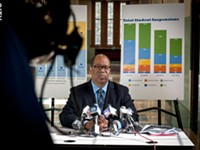
RCSD facing spending concerns
Sep 20, 2019 -

Education forum tomorrow night for downtown residents
Sep 17, 2019 - More »
